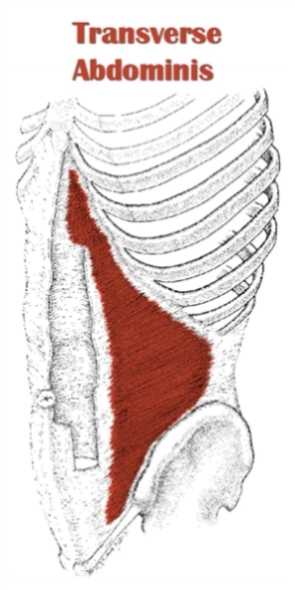The transversus abdominis (L. transversus, crosswise [trans, across ; vertere, to turn] ; abdo, to hide.) is a flat layer of muscle in the abdomen, whose fibers run transverse relative to the midline of the body.

It is responsible for compressing the abdominal wall, helping to support and protect the internal organs, and assist in forced expiration.
It also acts as a local stabilizer of the lumbar spine. That is, it stabilizes the individual vertebrae, but doesn’t actually move the trunk.
Exactly how important is its role in overall core stability (compared to other abdominal wall muscles)?…
…Well, that’s a hotly debated subject, which I’ll touch upon later in this post.
The transversus abdominis is the deepest lateral muscle pair in the anterolateral abdominal wall, lying deep to both the internal oblique and external oblique, on either side of the rectus abdominis.
It originates from the inguinal ligament, pelvis, lumbar fascia and lower ribs.
Its parallel-oriented fibers run medially and insert on an aponeurosis connecting to the linea alba and pelvic crest.
Also Called
- TVA, TA or TrA
- Transverse abdominis
- Transverse abdominals/Abs
- Transversalis muscle
- Corset muscle
Origin, Insertion, Action & Nerve Supply
| Muscle | Transversus Abdominis |
|---|---|
| Origin |
|
| Insertion | Linea alba and pubic crest (via transversus abdominis aponeurosis) |
| Action |
|
| Nerve Supply |
|
Exercises:
Note: The abdominal draw-in maneuver and stomach vacuum are the only two direct TVA exercises. However, I included the side plank and side bridge in chart below, since they’re arguably the best exercises for activating the TVA indirectly.
Isometric Exercises:
- Side plank
- Side bridge
Other Exercises:
- Abdominal draw-in maneuver
- Stomach vacuum
Stretches & Myofascial Release Techniques:
Stretches
- N/A
Self Myofascial Release Techniques
- N/A
Common Issues:
- There is often a weakness in, or poor neuromuscular control of, the transversus abdominis in individuals with lower back pain/injuries. However, whether this calls for isolating the TVA or strengthening it along with other abdominal wall muscles, is up for debate (see training notes, below).
Training Notes:
- It is a common misconception that the TVA is the main “player” in lumbar spine/core stabilization, and that isolating the TVA is necessary to achieve or improve good lumbar/core stability. The stomach vacuum and draw-in maneuver are two such techniques that are claimed to isolate this muscle. However, truly isolating the TVA is difficult for many people, even with guidance from a physical therapist. Furthermore, research by Dr. Stuart McGill, a leading lumbar spine expert, indicates that isolating the TVA is not beneficial for individuals with healthy lower backs; indeed, it may be harmful (particularly when combining the draw-in maneuver with exercises that involve compressive loading). McGill also suggests that isolating the TVA for people with lower back pain, a common prescription by physical therapists, is misguided – though this assertion is still hotly debated.
- The best way to train TVA is indirectly, such that it gets worked along with the other muscles of the abdominal wall (side planks and side bridges are your best bet for this). This way, you still strengthen and improve the endurance of the TVA, but you do so in the context of how it actually functions during daily activities and exercise.
- Other than being potentially useful for lower back pain treatment protocol, isolating the TVA with the draw-in maneuver or stomach vacuum may have a practical application for competitive bodybuilders. The stomach vacuum in particular can be useful for competitive bodybuilders, since the “front double bicep” and “ab quad” poses are often performed while doing a stomach vacuum to make the waist appear narrower. Additionally, some bodybuilders will claim that frequently doing direct TVA exercises will narrow your waist in the resting position, especially if your stomach naturally tends to protrude when relaxed – My inclination is to believe that this advice is broscience, but I can’t totally write it off since I haven’t tried it myself or seen any research on the topic.


Hi, I’m using Chrome. When I click on “Side Plank”, etc. in the table above, no images appear….
Hi Scott,
Sorry about that. I built that feature thinking I’d soon add a bunch of photos, but I never got to it because of work, life and other content. It’s still on my long to-do list.
Hey Alex, btw stretch for the TVA is very much applicable; assume the glute bridge position then for the right side, shift the pelvis and hips to the left, inhale gently and hold your breath, and push out your stomach upwards and to the right. Exhale and repeat stretch if muscle is tight. (It can get tight from a variety of excessive abdominal movements/exercises)
Thanks, Tim.